|
When
Christopher Columbus guided his ships west out of
the Spanish port of Palos, near Cadiz,
perhaps twenty-five million people made their home
in the Americas. Two empires were at their apogee,
controlling enormous swaths of territory. In the north
was the Aztec and the south, the Inka. Their peoples
carried on sophisticated lives in cities and towns,
producing elaborate objects and monuments. Within
each
empire, peoples of distinct languages and customs—Mixtecs,
Zapotecs, Guaraní, Chocho, and Cañari,
to
name just a few—made their lives in spaces defined
by the capital cities of Tenochtitlan and Cuzco, their
existences shaped by complex trade networks and local
politics.
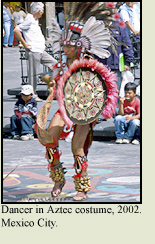 In
Vistas, the colonial period is understood
as the staging ground for constructing and re-constructing
pre-Columbian history, from 16th-century initial memories
to 19th-century proto-national concepts. In considering
the many ways in which colonial peoples made sense
of the pre-Columbian, the interpretations presented
here rest on the premise that there was no single,
stable pre-Columbian past in colonial Spanish America
(just as there is no single, stable pre-Columbian
or colonial past today). And it is precisely this
diversity and fluidity that Vistas seeks
to highlight, for it was precisely this diversity
and fluidity that characterized the pre-Columbian
in colonial times. In
Vistas, the colonial period is understood
as the staging ground for constructing and re-constructing
pre-Columbian history, from 16th-century initial memories
to 19th-century proto-national concepts. In considering
the many ways in which colonial peoples made sense
of the pre-Columbian, the interpretations presented
here rest on the premise that there was no single,
stable pre-Columbian past in colonial Spanish America
(just as there is no single, stable pre-Columbian
or colonial past today). And it is precisely this
diversity and fluidity that Vistas seeks
to highlight, for it was precisely this diversity
and fluidity that characterized the pre-Columbian
in colonial times.
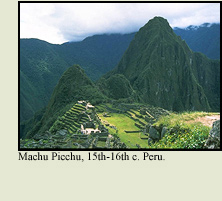 Across
the Americas, the history of indigenous cultures is
so long and so vibrant that by 1500, hundreds of histories
could be found inscribed in abandoned cities and half-buried
settlements. In the Yucatán, the landscape
was punctuated by crumbling ruins that had once been
the center of dazzling whitewashed cities. Built by
the ancestors of the Maya, many sites still held hieroglyphic
texts carved in stone or painted inside building walls.
In the highlands of Peru, Machu Picchu, seen in the
photograph, had been an Inka royal retreat. The city
was abandoned probably in the early 16th century;
its walls overgrown with orchid and bromeliad, even
as vibrant Andean communities made their living nearby. Across
the Americas, the history of indigenous cultures is
so long and so vibrant that by 1500, hundreds of histories
could be found inscribed in abandoned cities and half-buried
settlements. In the Yucatán, the landscape
was punctuated by crumbling ruins that had once been
the center of dazzling whitewashed cities. Built by
the ancestors of the Maya, many sites still held hieroglyphic
texts carved in stone or painted inside building walls.
In the highlands of Peru, Machu Picchu, seen in the
photograph, had been an Inka royal retreat. The city
was abandoned probably in the early 16th century;
its walls overgrown with orchid and bromeliad, even
as vibrant Andean communities made their living nearby.
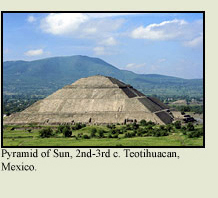 Living
peoples anchored their own pasts to these ancient
places, sustained and reshaped histories through their
own oral narratives, animated them through ritual
practice. For instance, the city of Teotíhuacan
was abandoned seven centuries before European conquest
and colonization. Once the most populous city with
the largest structures in North America, Teotíhuacan
was a ghost town in 1521 when Hernán Cortés
and his allies marched on the Aztecs. Yet the ruined
pyramids had not been forgotten. The Aztecs called
Teotíhuacan "The City of the Gods,"
after those they thought responsible for the monumental
architecture, and every twenty days the Aztec king
and his high priests made a ritual pilgrimage there.
Living
peoples anchored their own pasts to these ancient
places, sustained and reshaped histories through their
own oral narratives, animated them through ritual
practice. For instance, the city of Teotíhuacan
was abandoned seven centuries before European conquest
and colonization. Once the most populous city with
the largest structures in North America, Teotíhuacan
was a ghost town in 1521 when Hernán Cortés
and his allies marched on the Aztecs. Yet the ruined
pyramids had not been forgotten. The Aztecs called
Teotíhuacan "The City of the Gods,"
after those they thought responsible for the monumental
architecture, and every twenty days the Aztec king
and his high priests made a ritual pilgrimage there.
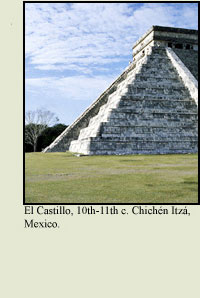 Before
the arrival of Europeans, then, the indigenous past
was both well honored and open to reinterpretation
by the descendants of those who came before. This
was a process that depended upon and lent new meanings
to visual culture, as peoples actively recast old
forms and places, reworking and reinterpreting them.
It was also a process that continued after the arrival
of Europeans, but was made more difficult by the profound
and devastating changes that were unleashed soon after
1492. The conquistadors had little interest in indigenous
histories: many an Inka witnessed the Spanish conquistadors
destroying ancient shrines—places where the
dead could speak to the living—in their zealous
search for silver and gold. Often Spaniards viewed
local history—embedded in objects and architectural
spaces—as an impediment to conquest. Thus, Aztecs
saw their glorious capital city reduced to rubble,
the life-size portraits of the Aztec kings gouged
off the living rock, and, as seen below, sacred objects
and manuscripts put to the torch. The transmission
of oral histories and living memories was severely
reduced by the countless deaths brought by new diseases.
While about twenty-five million Americans witnessed
the dawn of the 16th century, fewer than one million
would see the 17th. Before
the arrival of Europeans, then, the indigenous past
was both well honored and open to reinterpretation
by the descendants of those who came before. This
was a process that depended upon and lent new meanings
to visual culture, as peoples actively recast old
forms and places, reworking and reinterpreting them.
It was also a process that continued after the arrival
of Europeans, but was made more difficult by the profound
and devastating changes that were unleashed soon after
1492. The conquistadors had little interest in indigenous
histories: many an Inka witnessed the Spanish conquistadors
destroying ancient shrines—places where the
dead could speak to the living—in their zealous
search for silver and gold. Often Spaniards viewed
local history—embedded in objects and architectural
spaces—as an impediment to conquest. Thus, Aztecs
saw their glorious capital city reduced to rubble,
the life-size portraits of the Aztec kings gouged
off the living rock, and, as seen below, sacred objects
and manuscripts put to the torch. The transmission
of oral histories and living memories was severely
reduced by the countless deaths brought by new diseases.
While about twenty-five million Americans witnessed
the dawn of the 16th century, fewer than one million
would see the 17th.
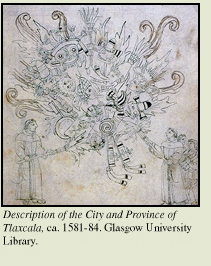 Spanish
conquerors and colonial officials tried to overwrite
these multiple histories with one of their own making.
To begin, they invented a new category of indio,
a name they gave to any native person from the Indies,
as Spanish possessions in the New World were called
(“natural” was also used). Spanish
conquerors and colonial officials tried to overwrite
these multiple histories with one of their own making.
To begin, they invented a new category of indio,
a name they gave to any native person from the Indies,
as Spanish possessions in the New World were called
(“natural” was also used).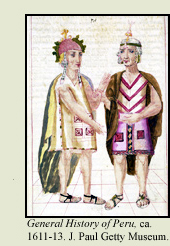 Indio was far more than convenient shorthand;
in Spanish America, the indio was someone
of different rights, a different order of personhood.
Indios were legal minors, cultural children.
And as they forced the status of indio upon
millions of dissimilar and distinct peoples, Spaniards
tried to fashion a common history for the Indies,
and connect it to Christian ideas about the shape
of history. Writers of the time called this history
a narrative “of the Indies.” It often
began with the creation of the earth, proceeded rapidly
to the indigenous empires of the 14th and 15th centuries,
and then climaxed with a successful Spanish conquest
and imposition of a universal Christianity. Today,
a fuller sense of the scope and depth of America’s
past exists, yet the blanket term “pre-Hispanic”
or “pre-Columbian” (that is, before Columbus)
is still used to describe the history of America before
the arrival of Europeans.
Indio was far more than convenient shorthand;
in Spanish America, the indio was someone
of different rights, a different order of personhood.
Indios were legal minors, cultural children.
And as they forced the status of indio upon
millions of dissimilar and distinct peoples, Spaniards
tried to fashion a common history for the Indies,
and connect it to Christian ideas about the shape
of history. Writers of the time called this history
a narrative “of the Indies.” It often
began with the creation of the earth, proceeded rapidly
to the indigenous empires of the 14th and 15th centuries,
and then climaxed with a successful Spanish conquest
and imposition of a universal Christianity. Today,
a fuller sense of the scope and depth of America’s
past exists, yet the blanket term “pre-Hispanic”
or “pre-Columbian” (that is, before Columbus)
is still used to describe the history of America before
the arrival of Europeans.
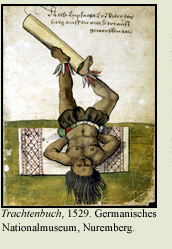 The
interpretations and images presented here explore
how peoples living in Europe and Spanish America made
sense of this pre-Columbian history, especially through
visual culture. Europe had little grasp of the depth
and complexity of indigenous histories, and the Indies
and their indio inhabitants could be a source
of awe and amusement. This was particularly true in
the 16th century, when native peoples were imported
to Europe as wondrous performers. Their crafted works
were taken from America as gifts for kings and cardinals.
Clearly European perspectives on the New World were
complex. Some defended the rights and privileges of
native peoples, yet prejudice and rumors of devil-worship
and cannibalism also became fixed in the European
imagination. And images of such evils circulated widely,
in books, prints, and the salons of the wealthy. The
interpretations and images presented here explore
how peoples living in Europe and Spanish America made
sense of this pre-Columbian history, especially through
visual culture. Europe had little grasp of the depth
and complexity of indigenous histories, and the Indies
and their indio inhabitants could be a source
of awe and amusement. This was particularly true in
the 16th century, when native peoples were imported
to Europe as wondrous performers. Their crafted works
were taken from America as gifts for kings and cardinals.
Clearly European perspectives on the New World were
complex. Some defended the rights and privileges of
native peoples, yet prejudice and rumors of devil-worship
and cannibalism also became fixed in the European
imagination. And images of such evils circulated widely,
in books, prints, and the salons of the wealthy.
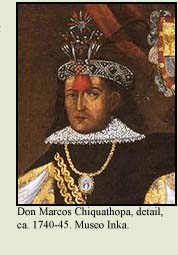 As
early as 1550, when Europeans first began to stabilize,
and indeed create a pre-Columbian past that paralleled
their own sense of history, they often collaborated
with native elders. Educated natives and mestizos—some
of whom had moved to Europe, others who remained in
Spanish America—also took up the pen to write
accounts of the past. Yet legions of others, be they
Zapotec, Nahua, Otomí, Chuncho, or Inka, held
on to their specific forms of cultural memory through
the preservation and creation of objects and rituals.
At times, the iconography of images—their depiction
of ancient rites or ancestors—directly referenced
the past. In other instances, it was the craftsmanship
or choice of materials that kept pre-Columbian traditions
and memories alive. In all instances, however, indigenous
contributions to colonial visual culture are a distinguishing
feature of Latin American history and colonization. As
early as 1550, when Europeans first began to stabilize,
and indeed create a pre-Columbian past that paralleled
their own sense of history, they often collaborated
with native elders. Educated natives and mestizos—some
of whom had moved to Europe, others who remained in
Spanish America—also took up the pen to write
accounts of the past. Yet legions of others, be they
Zapotec, Nahua, Otomí, Chuncho, or Inka, held
on to their specific forms of cultural memory through
the preservation and creation of objects and rituals.
At times, the iconography of images—their depiction
of ancient rites or ancestors—directly referenced
the past. In other instances, it was the craftsmanship
or choice of materials that kept pre-Columbian traditions
and memories alive. In all instances, however, indigenous
contributions to colonial visual culture are a distinguishing
feature of Latin American history and colonization.
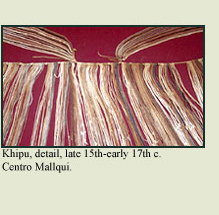 Throughout
the history of Spanish America, indigenous peoples
used visual things to both remember and represent
their past. Through the threads of memory and ancestry—at
times animated by oral recitations and performances
on feast days or other public occasions—a special
connection to the pre-Columbian past was claimed.
This connection could be quite literal, as when native
historians of the 16th and 17th centuries had the
knowledge to interpret khipus and ancient pictorial
manuscripts. Such objects, with their origins in pre-Hispanic
times, were often safeguarded in local towns in the
colonial period or else were ecopied. Through written
words and painted imagery, often in alphabetic script
and in paper and inks introduced by friars, indigenous
people also recalled and remade the past for their
own purposes. Throughout
the history of Spanish America, indigenous peoples
used visual things to both remember and represent
their past. Through the threads of memory and ancestry—at
times animated by oral recitations and performances
on feast days or other public occasions—a special
connection to the pre-Columbian past was claimed.
This connection could be quite literal, as when native
historians of the 16th and 17th centuries had the
knowledge to interpret khipus and ancient pictorial
manuscripts. Such objects, with their origins in pre-Hispanic
times, were often safeguarded in local towns in the
colonial period or else were ecopied. Through written
words and painted imagery, often in alphabetic script
and in paper and inks introduced by friars, indigenous
people also recalled and remade the past for their
own purposes.
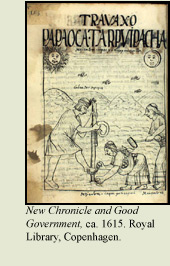 Just
as they had before the arrival of the Spanish, indigenous
histories always took form and meaning in ways useful
for the present. For instance, the Andean writer Felipe
Guaman Poma de Ayala (who wrote and painted in the
17th century) did not merely register the glories
of pre-Columbian times. Rather he shaped his history,
with scenes like this one, as a call to reestablish
native Andean rule. Descendants of the Inka and the
Aztec also invoked imperial histories for the express
purpose of holding onto threatened rights and properties.
Yet others represented their ancestral past as something
distinctly not Spanish and not Aztec (or not Inka)—in
a new, hybrid style that drew from multiple traditions.
And in this way they reaffirmed their separate ethnic
or town identities. Just
as they had before the arrival of the Spanish, indigenous
histories always took form and meaning in ways useful
for the present. For instance, the Andean writer Felipe
Guaman Poma de Ayala (who wrote and painted in the
17th century) did not merely register the glories
of pre-Columbian times. Rather he shaped his history,
with scenes like this one, as a call to reestablish
native Andean rule. Descendants of the Inka and the
Aztec also invoked imperial histories for the express
purpose of holding onto threatened rights and properties.
Yet others represented their ancestral past as something
distinctly not Spanish and not Aztec (or not Inka)—in
a new, hybrid style that drew from multiple traditions.
And in this way they reaffirmed their separate ethnic
or town identities.
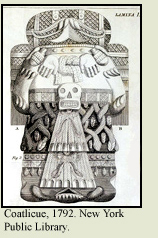 By
the time of independence in the early 19th century,
Creoles—not only native people—considered
pre-Columbian history as their own. Creole nationalists
were drawn to the imperial cultures encountered by
the conquerors, the Inka and Aztec, as illustrious
models and ancestral heroes of their homeland. And
while the images that Creoles generated of ancient
rulers in Cuzco or sculptures of the rulers of Tenochtitlan
were more often fanciful than factual, these representations
must be taken seriously as a set of practices through
which pre-Columbian history and visual culture were
invested with meaning in the late colonial period. By
the time of independence in the early 19th century,
Creoles—not only native people—considered
pre-Columbian history as their own. Creole nationalists
were drawn to the imperial cultures encountered by
the conquerors, the Inka and Aztec, as illustrious
models and ancestral heroes of their homeland. And
while the images that Creoles generated of ancient
rulers in Cuzco or sculptures of the rulers of Tenochtitlan
were more often fanciful than factual, these representations
must be taken seriously as a set of practices through
which pre-Columbian history and visual culture were
invested with meaning in the late colonial period.

|
